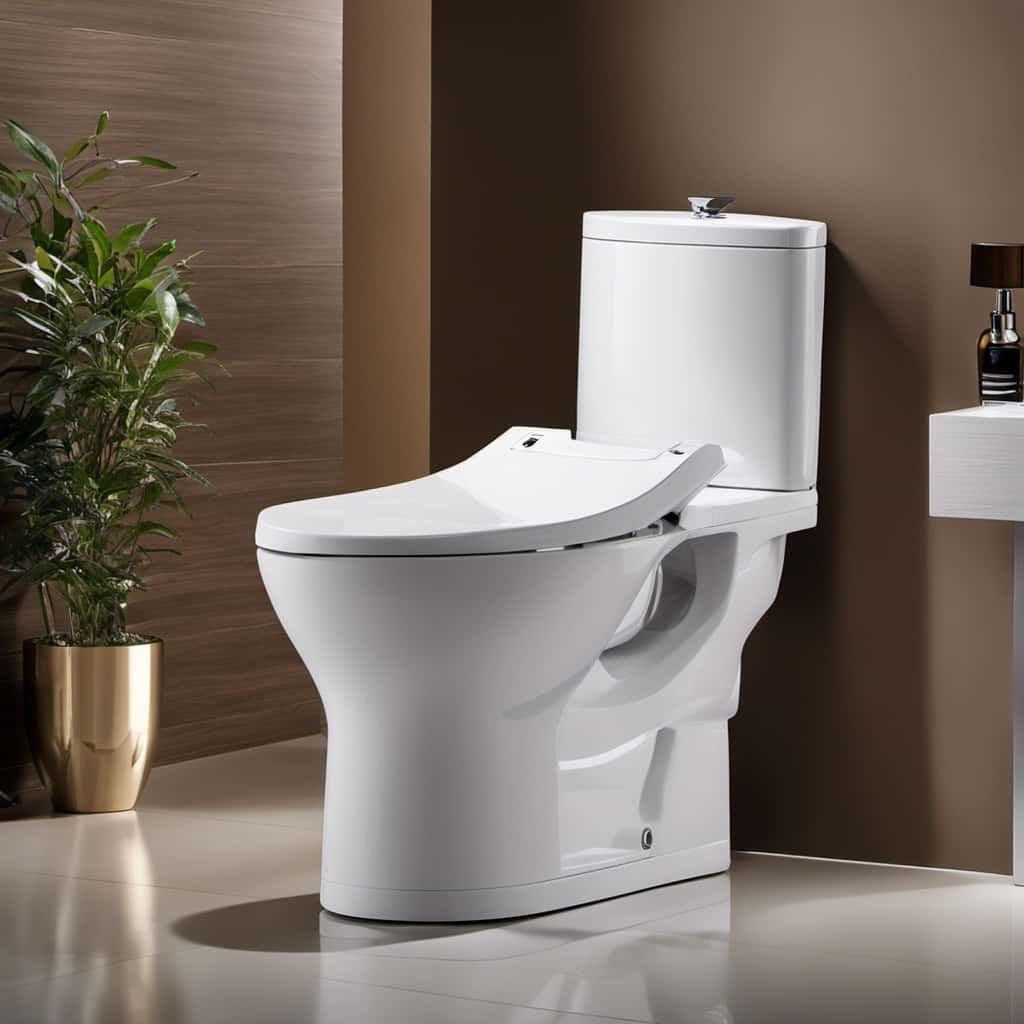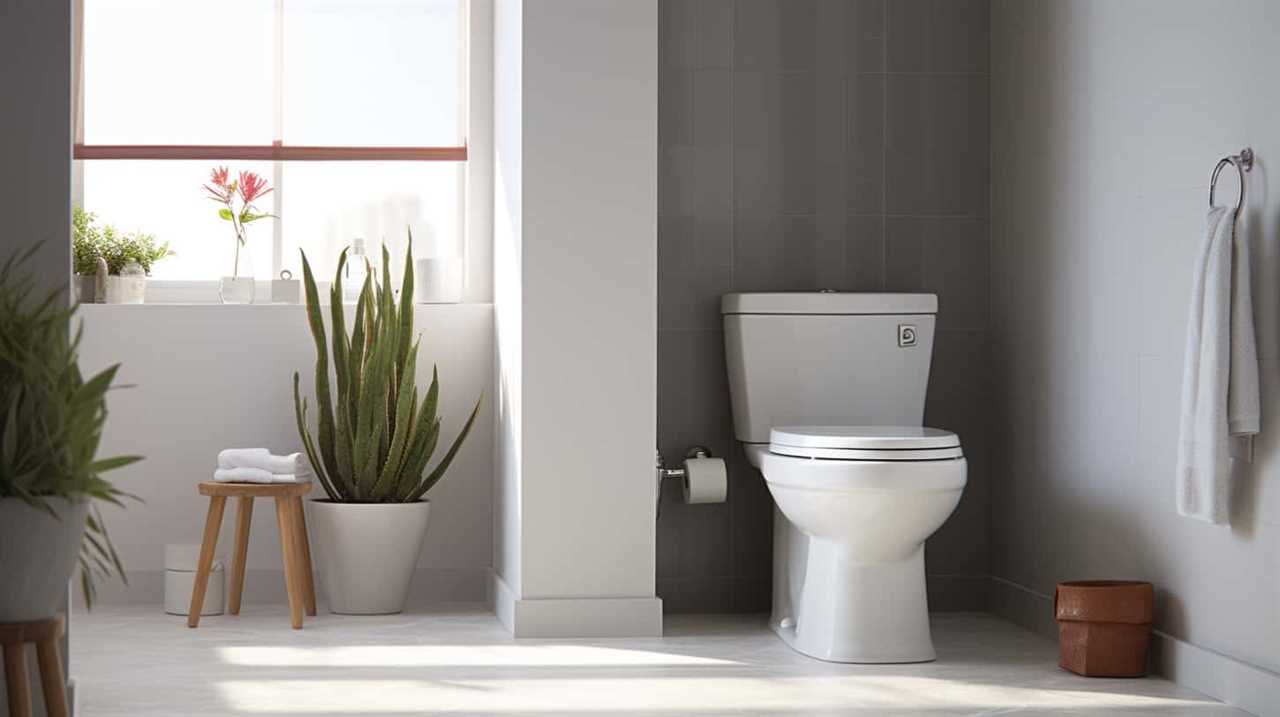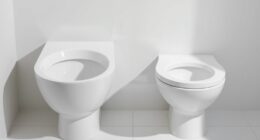Are you tired of dealing with a faulty flush valve? We’ve got you covered!
In this article, we will guide you through the process of determining the right toilet flush valve for your needs.
From identifying common signs of a faulty valve to measuring the size and understanding different types, we’ll provide you with all the technical information you need.
By the end, you’ll be equipped to master the art of replacing a toilet flush valve like a pro.

Key Takeaways
- Signs of a faulty flush valve include continuously running water, leaks, and a misaligned or worn-out float.
- Understanding the different types of flush valves, such as flapper valves and flushometer valves, can help in troubleshooting and maintenance.
- Regularly checking for leaks, cleaning the valve, and replacing worn-out parts are essential for maintaining a toilet flush valve.
- Measuring the flush valve size is crucial to ensure proper toilet performance and troubleshoot common issues.
Common Signs of a Faulty Flush Valve
One common sign of a faulty flush valve is when we notice water continuously running into the toilet bowl. This is often caused by toilet flush valve leaks, which can result in wasted water and higher utility bills. Troubleshooting a faulty flush valve involves a few simple steps.
First, we need to check the flapper or seal at the bottom of the tank to ensure it’s sealing properly. If there are any visible cracks or tears, it may need to be replaced.
Another possible issue could be a misaligned or worn-out float, which can cause the valve to stay open. By inspecting and addressing these common problems, we can prevent further water waste and ensure the efficient functioning of our toilet’s flush valve.
Understanding the different types of flush valves will further help us in selecting the appropriate replacement part.

Understanding the Different Types of Flush Valves
To understand the different types of flush valves, we need to start by familiarizing ourselves with their various functions and features. Flush valves are essential components of toilets that regulate the flow of water during flushing. There are two main types of flush valves: the flapper valve and the flushometer valve.
The flapper valve is the most common type of flush valve found in residential toilets. It consists of a rubber flapper that covers the flush valve opening. When the toilet is flushed, the flapper lifts, allowing water to flow from the tank into the bowl. Flapper valves are relatively simple and inexpensive, but they may require periodic replacement due to wear and tear.
On the other hand, flushometer valves are commonly used in commercial and public restrooms. These valves are operated by a handle or a sensor and are designed to deliver a powerful flush that can effectively clear waste from the bowl. Flushometer valves are generally more durable and require less maintenance than flapper valves.
To prolong the lifespan of a toilet flush valve, regular maintenance is necessary. Here are a few tips:

- Check for leaks: Inspect the flush valve for any signs of leakage and repair them promptly. A leaking flush valve can waste a significant amount of water and increase water bills.
- Clean the valve regularly: Over time, mineral deposits and debris can accumulate on the flush valve, affecting its performance. Clean the valve periodically using a mild cleaner to remove any buildup.
- Replace worn-out parts: If you notice any signs of wear or damage to the flush valve or its components, such as the flapper or seal, replace them promptly to prevent further issues.
Now, let’s move on to troubleshooting common issues with toilet flush valves.
Measuring Your Toilet’s Flush Valve Size
To determine the size of your toilet’s flush valve, we can measure the diameter of the valve opening. This is an important step because using the wrong size flush valve can lead to issues with your toilet’s performance.
Regular maintenance for toilet flush valves is crucial to ensure proper functioning and prevent any potential problems. By measuring the diameter of the flush valve opening, you can determine the size of the valve you need for replacement or repair.
Troubleshooting common issues with toilet flush valves, such as leaks or weak flushes, can be easier once you know the correct size of the flush valve. Understanding the size of your toilet’s flush valve is a fundamental aspect when considering factors to choose the right flush valve for your toilet.

Factors to Consider When Choosing a Flush Valve
When considering factors to choose the right flush valve for our toilet, we need to take into account various aspects. Proper installation techniques for toilet flush valves are crucial to ensure optimal performance and prevent any potential issues. It’s important to follow the manufacturer’s instructions and use the appropriate tools for installation.
Additionally, understanding the specific requirements of our toilet system, such as the water pressure and flow rate, can help us choose a flush valve that’s compatible and efficient. Troubleshooting common issues with flush valves can also guide our decision-making process. For example, if we frequently experience leaks or weak flushes, we may need to consider a flush valve with better sealing capabilities or increased water flow.
Considering these factors will help us choose the most suitable flush valve for our toilet. Now let’s move on to a step-by-step guide to replacing a toilet flush valve.
Step-By-Step Guide to Replacing a Toilet Flush Valve
Now, let’s delve into the practical process of replacing a toilet flush valve, ensuring a seamless transition and improved functionality. Troubleshooting common issues with toilet flushing problems can often be resolved by replacing the flush valve. Here is a step-by-step guide to help you through the process:

- Shut off the water supply to the toilet by turning the valve clockwise.
- Flush the toilet to drain the tank completely.
- Disconnect the water supply line from the bottom of the tank.
- Remove the nut securing the flush valve to the tank.
- Lift the old flush valve out of the tank and discard it.
- Install the new flush valve by placing it in the hole at the bottom of the tank.
- Secure the flush valve with the nut provided.
- Reconnect the water supply line.
- Turn on the water supply and check for any leaks.
- Test the flush valve by flushing the toilet several times.
Frequently Asked Questions
Can I Use Any Type of Flush Valve for My Toilet?
Yes, you can use different types of flush valves for your toilet. However, it’s important to choose the right one based on your toilet flush valve types and considering factors like water efficiency and compatibility.
How Do I Know if My Toilet’s Flush Valve Is Faulty?
We know if our toilet’s flush valve is faulty by looking for signs such as weak flushing, continuous running, or water leakage. Toilet flush valve repair is essential to prevent water wastage and maintain proper functionality.
What Are the Most Common Factors to Consider When Choosing a Flush Valve?
When choosing a flush valve, it’s essential to consider the durability and performance of the materials used. Additionally, having tips and troubleshooting advice for DIY installation is crucial for ensuring a successful installation process.
Are There Any Alternatives to Replacing a Toilet Flush Valve?
When it comes to maintaining toilet flush valves, there are alternatives to replacement. Troubleshooting common problems like leaks or weak flushing can often be resolved through valve cleaning or adjustment.

Can I Replace a Flush Valve Without Hiring a Professional Plumber?
Yes, we can replace a flush valve without hiring a professional plumber. DIY flush valve installation is possible with the right tools and instructions. It’s important to research and ensure compatibility with your specific toilet model.
Conclusion
To conclude, determining the right toilet flush valve may seem like a daunting task. However, by identifying common signs of a faulty valve, understanding the different types available, and measuring your toilet’s flush valve size, you can make an informed decision.
Don’t forget to consider factors such as water efficiency and ease of installation. These factors can play a significant role in your overall satisfaction with the chosen flush valve.
By following our step-by-step guide, you’ll be well-equipped to replace your toilet flush valve and keep your bathroom running smoothly.











